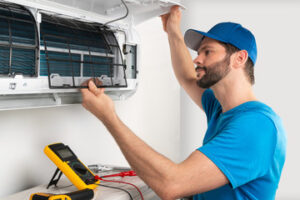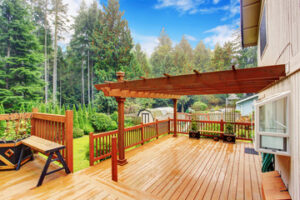Getting the most out of your air conditioning system requires regular professional maintenance. The smallest issues can quickly become larger ones, resulting in high energy bills and possibly a costly replacement bill.

Addressing drainage issues is crucial to ensuring optimal cooling performance. Using specialized tools, technicians can identify and clear blockages that could cause significant disruptions or damage to the system. Contact Ausco Air Heating & Air Conditioning for professional help.
A well-functioning AC drainage system is essential to your home’s comfort. As the air conditioner cools, it produces condensation that is drained away through the drain line and evaporator coils. This process helps to keep the indoor environment comfortable by maintaining a healthy humidity level. But if the evaporator coils or the drain line become clogged, your home will not be as well-drained as it should be. A clogged drain line can also lead to a variety of other problems with your cooling system.
If you think your ac unit may have a drainage problem, look for several clues:
Standing water is the most obvious sign that something is wrong. If you see it, shut off the AC and try to clean up the water as best you can (a mop or shop vac can help). Then, call your local HVAC service technician to check for a clog in the drainage line.
The drain line, which is usually a PVC pipe, is usually located outside near the base of the ac unit. To avoid clogging, make sure the ac drain pan is sloped correctly. If it isn’t, it can cause water to build up in the drain pan and overflow. This water can clog the line and create mold and mildew.
When the drain line becomes clogged, it restricts air flow within the ac unit, which can prolong cooling cycles and inhibit efficiency. It is not uncommon for debris such as mud, dirt, rocks, twigs, and leaves to get caught in the drainage line.
Clogged ac drain lines can be difficult to fix, especially if they aren’t caught early enough. But if you catch them early, it’s easy to unclog the drain line yourself by following simple steps. Just remember to shut off the power to your AC unit before working on it, as water and electricity are a dangerous combination. You’ll need a bucket or pan to catch the water in the drain line, a wire brush or pipe cleaner, and cleaning solution such as diluted bleach or vinegar. You’ll also need a tool such as a wet/dry vacuum to suction out the clog.
Dirty Condenser Coil
The air conditioning condenser coil is a critical component of an AC system. The copper coils are filled with refrigerant and help to remove hot air from your home and send it to the outdoor unit for cooling. Dirty coils cause many problems for your AC and can lead to the need for costly repairs. The key to avoiding dirty coils is routine maintenance and regular cleaning by a professional technician.
When the coil becomes clogged with dirt, dust, and debris, it causes your AC to consume more energy to cool your space. This can lead to increased energy bills and a shorter lifespan for your AC unit. In addition to high energy consumption, a dirty coil can also cause noises such as rattling or buzzing.
Dirty AC coils can be a sign of many other problems within your system. The most noticeable sign of a dirty coil is a decrease in the cooling performance of your home. This could be a gradual change or the system suddenly noticing that it has to run longer and harder to reach your desired temperature.
One of the main reasons for a dirty condenser coil is a lack of proper AC maintenance. This includes cleaning and removing any objects or structures that are close to the outdoor unit. Debris can easily block the fins of the coil and create a perfect environment for dirt to build up. It’s important to keep weeds, vines, and shrubs away from the outdoor unit to avoid blocking airflow and preventing debris accumulation.
Once the exterior unit is clear, your technician can gently brush or vacuum the dirty condenser coil to loosen any dirt or debris that has built up. Then, he or she will spray a commercially available coil cleaner onto the surface of the coil. Follow the manufacturer’s instructions for application and contact time to effectively clean the coil. A thorough rinsing with water will also help to remove any remaining debris or dirt. Afterward, the dealer can straighten the coil’s bent fins with a specialty tool to ensure optimal AC performance.
Faulty Compressor
One of the most common AC repair issues involves a faulty compressor. The compressor is what converts liquid refrigerant into cool air, and without it, your system will not work. There are a number of reasons that the compressor may fail, including physical damage, a bad clutch, or corrosion. These problems can be prevented by having your ac unit regularly maintained by a professional.
One sign of a problem with the compressor is if you notice that your AC is blowing warm air instead of cool air. The air flow through the vents should stay consistent. A sudden change could mean that the compressor is not working correctly and cannot pump refrigerant into your evaporator coils. A faulty compressor can also cause high energy bills, as it uses more power to function.
Another sign of a compressor problem is if it starts making banging noises. These sounds usually indicate that the compressor is not properly mounted or a component has become loose. This can lead to the compressor overheating and failing. Professionals can prevent this by ensuring that the compressor is properly anchored to the frame of the outdoor unit. Vibration isolation mounts can be installed to help reduce the amount of shaking.
A faulty compressor can also be the result of a poor suction line. If the suction line is too long or too short, it will not allow the compressor to receive the right amount of power. A professional can install the correct length of suction line to prevent this from happening.
If the compressor clutch is damaged, it won’t be able to engage the pulley and start the process of converting refrigerant into cool air. A rattling sound when the compressor is running means that the motor within the compressor has become loose and is thrashing around inside of the sealed unit that houses it. A pro can fix this problem, but it is not a job for an untrained person because of the high-pressure components involved.
If your circuit breakers keep tripping, it’s a good idea to get an AC repair technician out to take a look at the system. These trips are a sign that the compressor is overheating and drawing too much power, which can cause a fire hazard.
Leaking Freon
An air conditioner that is low on freon will run a lot more, racking up a big energy bill. This problem could also lead to major problems in the future, as the system is unable to cool your home effectively. So if you notice that your AC isn’t blowing cold air, the first thing you should do is check the refrigerant levels.
Many different things can cause a Freon leak, but one of the most common is erosion. The copper tubing used to deliver the freon is exposed to the elements, so it is more likely to erode than other parts of the machine. Erosion can cause tiny holes that lead to a leak, which is why it is so important to keep the level of Freon high in your unit.
The other big issue that can lead to a Freon leak is wear and tear. Specifically, the rubber seals on the valve stems can wear out and leak. Additionally, the outdoor system is susceptible to rust, especially from formic acid which corrodes copper tubes. It is a good idea to call for a professional ac repair service as soon as you think there may be a Freon leak, so that the issue can be fixed before it worsens.
Once the problem is identified, it will be necessary to find out where the leak is coming from. There are several ways to do this, but the most reliable is to use fluorescent dye. To do this, a technician will drain the system, then pressurize it with nitrogen. Once the pipes are full again, they will add a dye that is compatible with the type of refrigerant in the system. Then, when the leak occurs, it will show up as a bright spot under a black light.
Freon leaks can be very dangerous. They release a foul-smelling gas into the air that is extremely poisonous and can even cause death in severe cases of overexposure. Furthermore, they deplete the ozone layer and are bad for the environment. Because of these issues, a Freon leak must be repaired as quickly as possible. Although a technician can add more Freon to the system, they should also address the source of the leak and ensure it doesn’t happen again.

